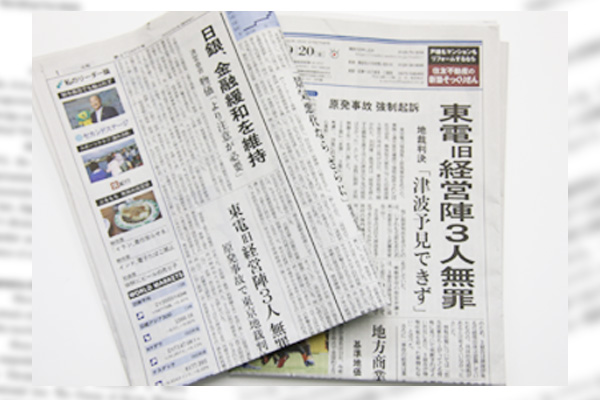The Tokyo District Court has acquitted all three former executives of Tokyo Electric Power Company Holding Inc. of professional negligence resulting in death over the TEPCO Fukushima Daiichi Nuclear Power Station accident triggered by tsunami of the 2011 Great East Japan Earthquake. At issue in the trial for the three, who were indicted under a ruling by a judicial review panel comprising ordinary citizens, was whether they could predict any huge tsunami tidal wave. The three at an inhouse meeting got aware of a TEPCO subsidiary’s estimate indicating the possibility of a tsunami wave of up to 15.7 meters hitting the nuclear power station, based on a governmental panel’s long-term earthquake prediction assessment. Lawyers serving as prosecutors in the trial claimed that the three were able to predict the tsunami. However, the court concluded that the tsunami was not predictable enough for the three to be required to suspend the power station’s operation.
Ignored Doko’s request for reviewing the power station design
The accident is fundamentally attributable to the height of the power station’s site and its layout design. Tohoku Electric Power Co. fixed the height of a site for its Onagawa Nuclear Power Station in Miyagi Prefecture at 15 meters after consideration at a commission including earthquake and tsunami experts. Meanwhile, TEPCO rejected then Toshiba Corp. President Toshiwo Doko’s request for Japanese engineers to review the Fukushima Daiichi Nuclear Power Station design by General Electric Co., according to a book authored by Doko, who quoted TEPCO as having said, “Don’t do what is not required.” A person who served as a TEPCO executive during the construction of the power station told the NHK TV station after the accident that working-level managers had been left to decide on the location of a diesel power generator to safely cool a nuclear reactor in emergency. This indicates that then TEPCO executives had failed to recognize the importance of safety. The gap between the two electric power companies’ executives in the preparedness for safety differentiated the Fukushima Daiichi from the Onagawa that resisted the earthquake with a magnitude of 9.0 on the Richter scale and tsunami in March 2011.
However, the Fukushima Daiichi had a chance to reduce its disaster. In the U.S. after the terrorist attacks on September 11, 2001, the Nuclear Regulatory Commission ordered electric power companies to take counterterror measures called B5b to prevent a reactor core from being damaged even if power transmission lines are cut and coolant pumps are destroyed. Emergency power supply vehicles, pumper trucks and coolant water reservoirs were provided at nuclear power plants that complied with the NRC order. The then Nuclear and Industrial Safety Agency in Japan sent a staff team to the U.S., getting the B5b document. However, it failed to order Japan’s electric power companies to take measures equivalent to the B5b counterterror measures.
Japan lacked talks on how to enhance safety
While many media organizations in Japan have criticized TEPCO alone for having failed to prevent the Fukushima Daiichi accident, the government in fact had lacked thorough regulations. The Nuclear Safety Commission had urged that filter vent equipment be installed at nuclear power plants to remove radioactive materials in the event of accident. However, some critics raised opposition to electric power companies’ proposals for installing such equipment, saying such equipment would be required because accidents are predictable. A conclusion was that filter vent equipment would not be installed because there would be no accident. In this way, a myth was established that nuclear power plants were safe.
Most of nuclear power plants in Europe have been accompanied by filter vent equipment since even before the Chernobyl nuclear power plant accident in the former Soviet Union. In the U.S., safety review standards include flood countermeasures for riverside nuclear power plants. At many of nuclear plants, emergency diesel power generators are installed in watertight buildings. Amid a fierce dispute between proponents and opponents of nuclear power plants, Japan had long lacked talks on how to enhance nuclear plant safety that had naturally been conducted in other countries.
Tadashi Narabayashi is a specially appointed professor at the Tokyo Institute of Technology and a director at the Japan Institute for National Fundamentals.


